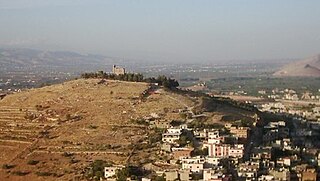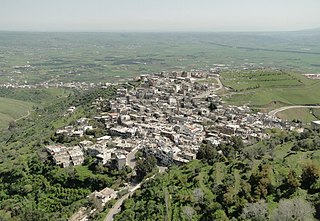
The Maronite Catholic Eparchy of Saint Maron of Sydney is an overseas Maronite rite eparchy (diocese) of the Catholic Church in Australia, based in Sydney. In 2010 there were 160,000 members. It is currently ruled by Eparch Antoine-Charbel Tarabay, OLM.

The tourism industry in Lebanon has been important to the local economy historically and to this day comprises a major source of revenue for the country. Before the Lebanese Civil War, Beirut was widely regarded as "The Paris of the Middle East" or also "The Pearl of the Middle East" often cited as a financial and business hub where visitors could experience Levantine Mediterranean culture, cuisine, history, archaeology, and architecture of Lebanon.

Collège Notre-Dame de Jamhour is a private Catholic primary and secondary school, located in Jamhour, in the Baabda District of the Mount Lebanon Governorate, Lebanon. The co-educational French-language school was founded by the Society of Jesus.

Qala'at Sanjil and Qala'at Tarablus in Arabic, is a citadel and fort on a hilltop in Tripoli, Lebanon. Once known as The Citadel of Raymond de Saint-Gilles and also as Mons Peregrinus, it takes its name from Raymond of Saint-Gilles, a Crusader commander who was a key player in its enlargement. It is a common misconception that he was responsible for its construction when in 1103 he laid siege to the city. In fact in the early 19th century, the citadel was extensively restored and rebuilt by the Ottoman governor of Tripoli Mustafa Agha Barbar and in consequence very little of the original Crusader structure has survived until this day.

Majdal Anjar is a village of Beqaa Governorate, Lebanon. Majdal Anjar is an overwhelmingly Sunni Muslim town.

Kaukaba, Kaukabet El-Arab or Kaukaba Station is a village in the Hasbaya District in the Nabatiye Governorate in southern Lebanon.
Ras Baalbek I is a rock shelter 500 m (1,600 ft) east of Ras Baalbek in the northern Beqaa Valley in Lebanon. It sits north of the Wadi Teniyet er-Râs valley at a height of 1,000 m (3,300 ft). It was first discovered by Lorraine Copeland and Peter Wescombe in 1965–1966. It was later excavated by Jacques Besançon in 1970. Retouched blades along with a pressure-flaked arrowhead and a burin were found dated to the Neolithic period.
Tell Ain Nfaikh or Ain Nfaikh is an archaeological site in an area c. 100 square metres (1,100 sq ft) of a ploughed field 300 metres (980 ft) east of the Litani, north of Rayak on the west of the Beqaa Valley in Lebanon.
Tahun ben Aissa is an archaeological site about 3.5 kilometres southwest of Joub Jannine in the Beqaa Valley in Lebanon.
Antelias Cave was a large cave located 2.5 km (1.6 mi) east of Antelias, 10 km (6.2 mi) northeast of Beirut close to the wadi of Ksar Akil.

The architecture of Lebanon embodies the historical, cultural and religious influences that have shaped Lebanon's built environment. It has been influenced by the Phoenicians, Romans, Byzantines, Umayyads, Crusaders, Mamluks, Ottomans and French. Additionally, Lebanon is home to many impressive examples of modern and contemporary architecture. Architecturally notable structures in Lebanon include ancient thermae and temples, castles, churches, mosques, hotels, museums, government buildings, souks, residences and towers.

Maronite Catholic Eparchy of Saint Maron of Brooklyn is an entity pertaining to the Apostolic Maronite Patriarchal Church of Antioch and is a diocese of the Maronite Church for the east coast of the United States, being headquartered in Brooklyn, New York. In conformity with the Code of Canons of the Eastern Churches (CCEO), the eparchy is under the direct jurisdiction of the Roman Pontiff. In 2017 there were 33,000 baptized. It is currently ruled by eparch Gregory John Mansour.
Tell Karmita is an archaeological site 4 km north of Bar Elias, on the Zahle road in the Beqaa Mohafazat (Governorate), Lebanon. It dates at least to the Neolithic with early Iron Age materials also found.
Tell Neba'a Chaate is an archaeological site 6 km north of Maakne in the Beqaa Mohafazat (Governorate) in Lebanon. It dates at least to the Early Bronze Age.
Tell Shamsine is an archaeological site 1.75 km north northeast of Ain Anjar in the Beqaa Mohafazat (Governorate) in Lebanon. It dates at least to the Neolithic.
Tell Taalabaya is an archaeological site 2.5 km southwest of the bridge at Maalaka in the Beqaa Mohafazat (Governorate) in Lebanon. It dates at least to the Neolithic.

The Battle of Hosn was a one-day battle during the Syrian Civil War around the village of Hosn and its proper center in the 900-year-old medieval Crusader castle of Krak des Chevaliers, a UNESCO world heritage site, that had been in the hands of rebel fighters along with Hosn itself since 2012. The Syrian Army's objective during the battle was to sever the rebels' supply routes for recruits and weapons coming in and out of Lebanon.
This page is based on this
Wikipedia article Text is available under the
CC BY-SA 4.0 license; additional terms may apply.
Images, videos and audio are available under their respective licenses.












